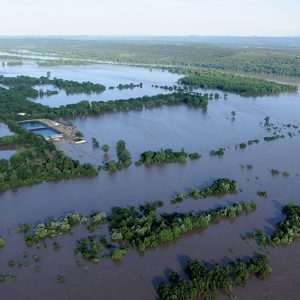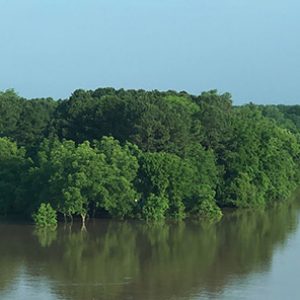calsfoundation@cals.org
Climate Change
aka: Global Warming
The spring of 2019 brought record flooding along the Arkansas River from Van Buren (Crawford County) to its confluence with the Mississippi River in the east. Historic crests occurred at Dardanelle (Yell County), Morrilton (Conway County), Toad Suck Lock and Dam near Conway (Faulkner County), and Pendleton (Desha County) between May 30 and June 6. In July 2019, the National Weather Service reported that the remnants of Hurricane Barry dumped 16.17 inches of rain on Dierks (Howard County), the most rain ever measured in a twenty-four-hour period (1:00 p.m. July 15 through 1:00 p.m. July 16) in Arkansas; the three-day total of 16.59 inches was the most rain associated with a tropical system in recorded state history. Murfreesboro (Pike County) also set a new daily record. Later in 2019, a record string of days with recorded temperatures of over 90 degrees, but almost no rain, occurred in September; the first eighteen days of September were above 90 degrees, nine of those over 95.
It is well known that these types of events occur across time, but as the planet is warming, it is a matter of some concern that record breaking may become the norm and Arkansas might experience an increase in frequency, intensity, or both in extreme events. It is a fact that warming is occurring; incoming solar energy exceeds outgoing solar energy by nearly one full watt per square meter. About 97 percent of climate scientists believe that this is the result of the introduction, primarily through the burning of fossil fuels, of carbon dioxide and other greenhouse gases to the atmosphere, trapping heat. Twenty percent or more of these added gases may remain in the atmosphere for possibly thousands of years; thus, warming is expected to continue.
Multiple studies using various climate models (an example being the “business-as-usual” model, in which economic growth is preferable to environmental protection and current rates of carbon dioxide continue to be added to the atmosphere throughout the model run) have looked at how warming will affect convective storms, including tornadoes and severe thunderstorms, drought, floods, heat waves and cold snaps, tropical storms, and winter storms. There are several pathways by which changes to the “normal” might be introduced. Many studies note that as increasing warmth occurs in the Arctic, the upper-level west-to-east winds that drive systems (called the jet stream) will be affected due to less temperature dissimilarity across the northern hemisphere. Some researchers observe that a slower jet stream results in a loopy, meandering pattern, causing systems to stall, especially during the summer, sometimes for weeks. These patterns can result in long-lasting intense heat or cold, drought, flooding rains, and other weather anomalies. The simple addition of heat and humidity (because hot air can hold more moisture) to some equations can potentially exacerbate many of these events.
Drought and Heat Waves
Like most of the world, Arkansas has experienced many of its warmest years on record this century: six out of the top ten warmest years took place since 2000 (by comparison, globally, nine of the top ten and sixteen of the seventeen of the warmest years occurred in the twenty-first century). Overall, Arkansas and other portions of the Southeast do not show as intense a warm-up as the northern tier of the country. But Arkansas suffered an exceptional drought in 2012 across nearly fifty percent of the state and while also shattering multiple heat records under the influence of a “stuck” pattern, such as was mentioned previously. This drought cost ranchers across the state approximately $128 million due to a lack of hay for feed, causing Governor Mike Beebe to declare a drought emergency. Studies show that dry long-duration events (LDEs), including specifically the 2012 drought, have been occurring more frequently since the mid-twentieth century, and especially since around the beginning of the 2000s. However, while wet events have also increased across many parts of the country, Arkansas bucks the trend: it is one of the only regions to experience a decrease in LDEs. Another study anticipates a fifty-percent increase in these high-amplitude blocking patterns given the “business-as-usual” model, though variation occurs among other models. More than one study finds Arkansas looking toward increasing heat and drought, especially in summer and autumn—again, against national trends. Drought also is responsible for wildfires, such as those that occurred in 2012, resulting in the evacuation of several thousand residents in Pope and Yell counties. In 2023, much of the southern portion of the United States experienced a multi-month heat wave that saw large parts of Arkansas placed under heat advisory alerts, with daytime temperatures exceeding 100 degrees and heat indices reaching even higher. At the start of the school year in August, several school districts made the decision to dismiss students early due to the severity of the heat and the lack of school buses with air conditioning. Research published in the November 2024 issue of Ecological Indicators demonstrated an increased frequency of drought in Arkansas, especially in the Arkansas Delta region, including the prevalence of so-called “flash droughts,” or short periods of severe temperature rise between rainfalls.
Severe Convective Storms
There is much debate over the question of how severe storms of all varieties will be affected by climate change. These studies are fraught with issues related to a lack of data or data integrity in past recordkeeping on all modes of severe weather, making teasing out trends difficult. Further, global climate models have not in the past been very local in nature, making local-scale events more difficult to study. As such, many researchers have begun looking at the conditions on days that produce severe weather of all types. Multiple studies find relatively strong increases in the potential for severe storms, noting that increased surface temperatures and moisture make for some explosive ingredients for storms, but uncertainty remains high regarding how a warmer upper atmosphere might put a check on initiation of storms. Shear—which is a term for the change of wind that allows air to lift, making storms grow vertically—is expected to decrease in the future, especially tornadic storms, while CAPE (convective available potential energy) is expected to increase, although there is disagreement about what this means in the future. Arkansas itself is included in an area of “robust” increases in the number of days with severe parameters; more importantly, these increases occur during the severe-storm season (March, April, and May). An increase in days with high potential for severe storms occurs in all other months of the year in Arkansas as well. It must be understood, too, that some of the most violent tornadoes in U.S. history were initiated in low-shear, high-CAPE environments, along boundaries left over from prior convection. The integration of local boundaries from storms into global climate models seems unlikely in the near future. A more important measure that has not been extensively explored is low-level humidity; if some of the models mentioned above that predict drought in Arkansas turn out to be correct, severe parameters will likely be affected, resulting in lower numbers of severe storms. Soil moisture feedbacks play an important inverse role in temperature—as moisture goes down, temperatures go up, exacerbating further drought and keeping a lid on vertically developing storms.
Flooding and Extreme Precipitation Events
Many studies have found significant increases in the number and intensity of extreme precipitation events since 1900, especially in the Midwest and Southeast, including Arkansas. Perhaps more notable for Arkansas, regions upstream of the Arkansas River show a large increase in return rates of extreme precipitation events, such as those that occurred in the spring of 2019, resulting in massive flooding along the river. So while the state may not see such increases itself, effects from nearby regions could be equally devastating. All of these studies, however, caution that multiple anthropogenic factors aside from climate change—such as increases in urbanized, impermeable surfaces; removal of vegetation; and expansion of flood protection and/or navigation systems—all play a role in flooding intensity and probability.
Extreme Cold and Winter Storms
While there has been a large uptick in the number of severe regional snowfalls since 1960 (two times as many as in the preceding sixty years), this trend has not been seen in Arkansas. Arkansas is, of course, not known for snowstorms but is more prone to ice storms; however, there is currently not enough data to see if a trend can be determined with regard to icing events anywhere in the United States. Cold snaps across the country are predicted to be less cold, and, in fact, that trend is in place.
Tropical Storms
Finally, Arkansas is frequently affected by tropical storms, usually in the form of depressions moving northward from Texas and Louisiana. There is increasing evidence that warmer oceans and perhaps even the previously mentioned blocking patterns mean more intense and wetter tropical cyclones that intensify more quickly and stall more often, although research as to any correlation to climate change is just beginning with reference to the latter. Storms such as Barry that dumped record rains on Arkansas might therefore become more common if stronger circulations remain viable farther into the Mid-South. There has not been an increase in the number of hurricanes, but there definitely has been an increase in their strength, size, and duration, including heavy rain. These tropical depressions also are responsible for tornadoes in the state (for example, Rita in 2005 and Gustav and Ike in 2008), albeit generally weak ones. Any strengthening of tropical storms could easily lead to an increase and/or enhancement of flooding rains, tropical-storm-force winds, and tornadoes well beyond coastal regions.
State-Level Political Response
In 2021, the Arkansas General Assembly approved, and Governor Asa Hutchinson signed into law, Act 308, which prohibits local governments from adopting any ordinance aimed at limiting the energy source utility customers might prefer. The state’s natural gas industry had lobbied heavily for the bill.
For additional information:
Alzurgqani, Shadia A., Hamdi A. Zurqani, Don White Jr., Kathleen Bridges, and Shawn Jackson. “Google Earth Engine Application for Mapping and Monitoring Drought Patterns and Trends: A Case Study in Arkansas, USA.” Ecological Indicators 168 (November 2024). https://doi.org/10.1016/j.ecolind.2024.112759 (accessed November 29, 2024).
Choi, Junyeong, Nana Tian, Jianbang Gan, Matthew Pelkki, and Ourname Mhotsha. “Growth Response of Red Oaks to Climactic Conditions in the Lower Mississippi Alluvial Valley: Implications for Bottomland Hardwood Restoration with a Changing Climate.” Climate 11.1 (2023). https://doi.org/10.3390/cli11010010 (accessed January 20, 2023).
Diffenbaugh, Noah S., Martin Scherer, and Robert J. Trapp. “Robust Increases in Severe Thunderstorm Environments in Response to Greenhouse Forcing.” Proceedings of the National Academy of Sciences of the United States (PNAS) 110 (October 8, 2013): 16361–16366. Online at https://www.pnas.org/content/110/41/16361 (accessed December 20, 2019).
Donahou, Richie. “Evaluating Climate Change Policy through the Endangered Species Act.” PhD diss., University of Arkansas, 2018. Online at https://scholarworks.uark.edu/etd/2936/ (accessed July 6, 2022).
Eley, Ashton. “Experts: Extreme Weather Growing More Common.” Arkansas Democrat-Gazette, March 8, 2021, pp. 1B, 6B. Online at https://www.arkansasonline.com/news/2021/mar/08/experts-extreme-weather-growing-more-common/ (accessed June 13, 2022).
Elsner, James B., Svetoslava C. Elsner, and Thomas H. Jagger. “The Increasing Efficiency of Tornado Days in the United States.” Climate Dynamics 45 (August 2015): 651–659. Online at https://doi.org/10.1007/s00382-014-2277-3 (accessed December 20, 2019).
Golliher, Travis. “A Wedge in Climate Initiatives: How State Legislatures’ Preemption of Local Governments Role in Climate Change Policy and Arkansas’ Act 308 of 2021 Are Misplaced.” University of Arkansas at Little Rock Law Review 45 (Winter 2022): 323–348.
Hale, Rachel B., Keneshia Bryant-Moore, and Anna Eichenberger. “Climate Change and Health Risk Perceptions of Arkansas Small Farmers through the Application of the Health Belief Model.” International Journal of Environmental Research and Public Health 21.7 (2024). Online at https://www.mdpi.com/1660-4601/21/7/955 (accessed July 24, 2024).
Heard, Kenneth. “Tornadoes Increasing in Arkansas Due to Climate Change, Researcher Says.” Arkansas Nonprofit News Network, June 6, 2021. https://arknews.org/index.php/2021/06/06/tornadoes-increasing-in-arkansas-due-to-climate-change-researcher-says/ (accessed June 7, 2021).
Kunkel, Kenneth E., et al. “Monitoring and Understanding Trends in Extreme Storms: State of Knowledge.” Bulletin of the American Meteorological Society 94 (2013): 499–514. Online at https://journals.ametsoc.org/doi/full/10.1175/BAMS-D-11-00262.1 (accessed December 20, 2019).
Magugu, John Westley. “Agro-Climactic Change, Crop Production and Mitigation Strategies—Case Studies in Arkansas, USA and Kenya.” PhD diss., University of Arkansas, 2016. Online at https://scholarworks.uark.edu/etd/1647/ (accessed July 6, 2022).
Mani, Amir. “Conjunctive Management of Water Resources under Climate Change Projection Uncertainty.” PhD diss., Louisiana State University, 2016. Online at https://digitalcommons.lsu.edu/gradschool_dissertations/3058/ (accessed June 13, 2022).
Mantooth-Hendrix, Deanna. “When It Rains, It Pours: A Case Study of Spatio-Temporal Variations in High-Intensity Precipitation Events in Arkansas” MS thesis, University of Arkansas, 2021. Online at https://scholarworks.uark.edu/etd/4009/ (accessed July 6, 2022).
McFadin, Daniel. “Schools Dismiss Early for Extreme Heat.” Arkansas Democrat-Gazette, August 25, 2023, pp. 1A, 7A. Online at https://www.arkansasonline.com/news/2023/aug/25/no-air-conditioning-in-buses-prompts-pcssd-other/ (accessed August 25, 2023).
Paschal, Olivia. “Summer in the South Is Becoming Unbearable.” The Atlantic, July 1, 2023. https://www.theatlantic.com/science/archive/2023/07/south-extreme-heat-wave-texas-climate-change/674598/ (accessed July 6, 2023).
Platt, Ainsley. “Rising Temperatures Strain State’s Farmers.” Arkansas Democrat-Gazette, February 9, 2025, pp. 1B, 3B. Online at https://www.arkansasonline.com/news/2025/feb/08/decades-of-rising-temperatures-putting-strain-on/ (accessed February 10, 2025).
———. “State Droughts More Severe, Frequent Researchers Find.” Arkansas Democrat-Gazette, November 29, 2024, pp. 1A, 3A. Online at https://www.arkansasonline.com/news/2024/nov/28/arkansas-researchers-work-has-helped-determine/ (accessed November 29, 2024).
———. “Utilities Looking to the Future as Climate Changes.” Arkansas Democrat-Gazette, September 23, 2024, pp. 1A, 3A. Online at https://www.arkansasonline.com/news/2024/sep/22/with-severe-weather-becoming-more-common/ (accessed September 23, 2024).
Powell, Phillip. “Historic Flooding Set Arkansas Rice Growing Back for Months, and Climate Change Was Part of It.” Arkansas Times, July 21, 2025. https://arktimes.com/arkansas-blog/2025/07/21/historic-flooding-set-arkansas-rice-growing-back-for-months-and-climate-change-was-part-of-it (accessed July 21, 2025).
Powell, Phillip, Illan Ireland, and Cassandra Stephenson. “As Climate Threats to Agriculture Mount, Could the Mississippi River Delta Be the Next California?” Arkansas Times, August 19, 2024. https://arktimes.com/arkansas-blog/2024/08/19/as-climate-threats-to-agriculture-mount-could-the-mississippi-river-delta-be-the-next-california (accessed August 19, 2024).
Roberts, Michael. “Dry Event Trends and Frequencies in the South Central United States.” MS thesis, Louisiana State University, 2010. Online at https://digitalcommons.lsu.edu/gradschool_theses/1423/ (accessed June 13, 2022).
Seeley, Jacob T., and David M. Romps. “The Effect of Global Warming on Severe Thunderstorms in the United States.” Journal of Climate of the American Meteorological Society 28 (2015): 2443–2458. Online at http://dx.doi.org/10.1175/jcli-d-14-00382.1 (accessed December 20, 2019).
Trapp, Robert J., Noah S. Diffenbaugh, Harold E. Brooks, Michael E. Baldwin, Eric D. Robinson, and Jeremy S. Pal. “Changes in Severe Thunderstorm Environment Frequency during the 21st Century Caused by Anthropogenically Enhanced Global Radiative Forcing.” Proceedings of the National Academy of Sciences of the United States (PNAS) 104 (December 11, 2007): 19719–19723. Online at https://doi.org/10.1073/pnas.0705494104 (accessed December 20, 2019).
Trapp, Robert J., Noah S. Diffenbaugh, and Alexander Gluhovsky. “Transient Response of Severe Thunderstorm Forcing to Elevated Greenhouse Gas Concentrations.” Geophysical Research Letters 36 (January 2009).
Ugarte, Eliezer. “Urbanization, Climate Change, and Water Quality in Northwest Arkansas Caves.” MS thesis, University of Arkansas, 2025.
Van Klooster, Sarah L., and Paul J. Roeber. “Surface-Based Convective Potential in the Contiguous United States in a Business-as-Usual Future Climate.” Journal of Climate 22 (June 15, 2009): 3317–3330. Online at https://journals.ametsoc.org/doi/pdf/10.1175/2009JCLI2697.1 (accessed December 20, 2019).
Mary Sue Passe-Smith
University of Central Arkansas



 Toad Suck and Murray Lock and Dam Flooding
Toad Suck and Murray Lock and Dam Flooding  Two Rivers Park
Two Rivers Park 



Comments
No comments on this entry yet.